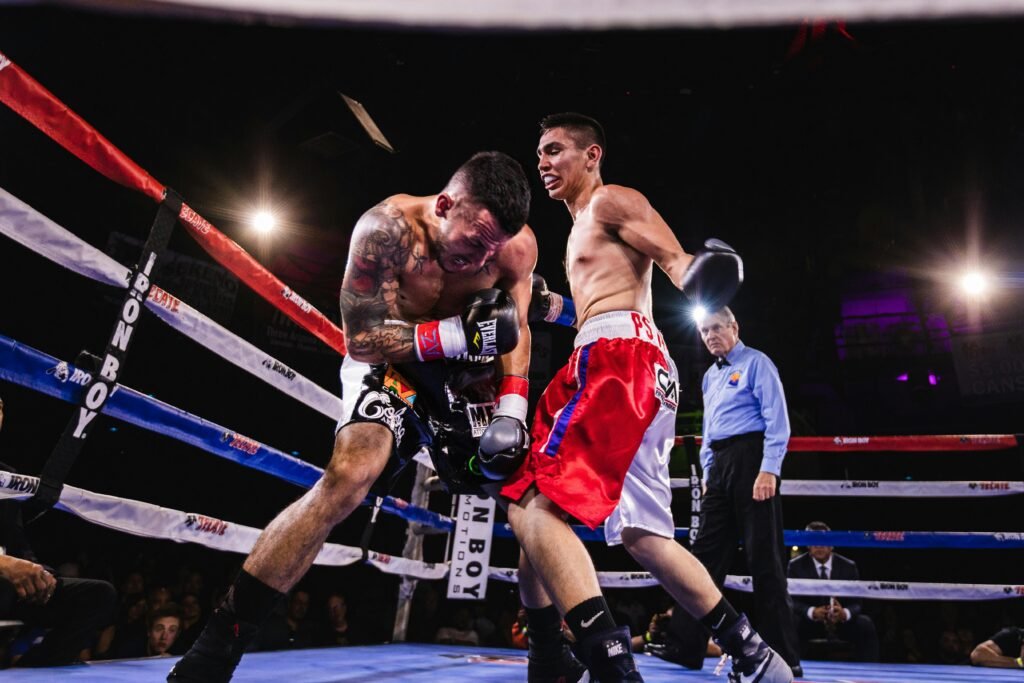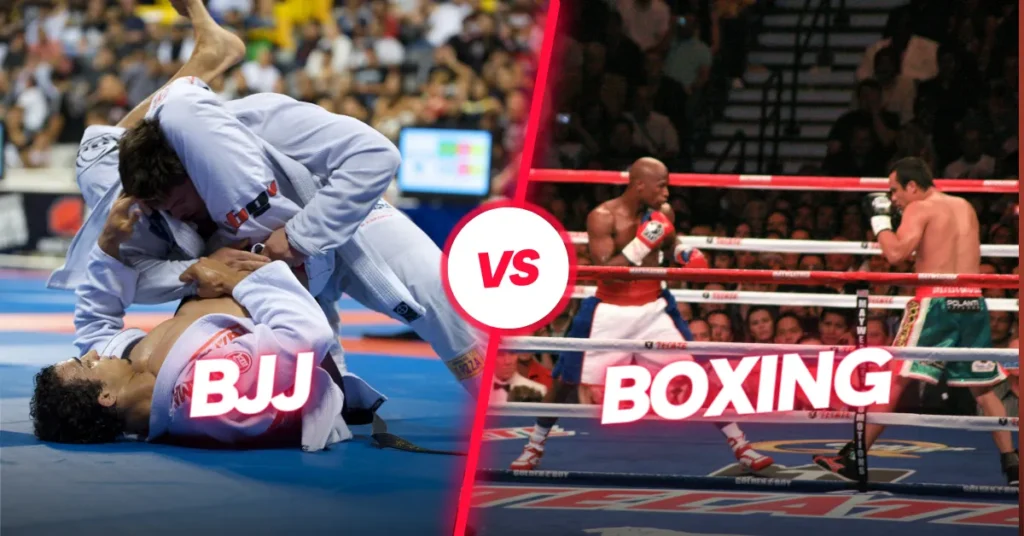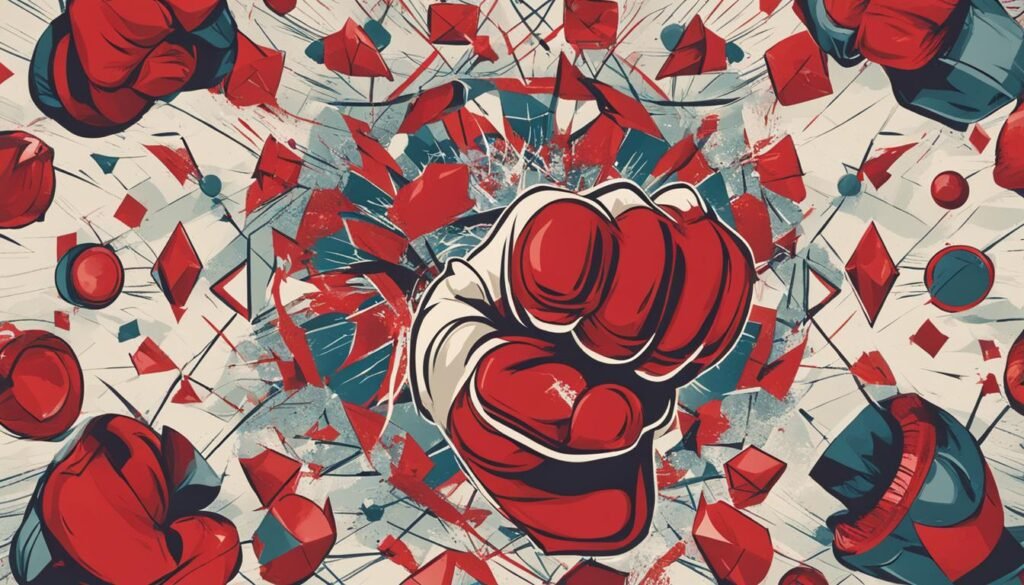Boxing, also known as “western boxing” or “pugilism,” is a combat sport and martial art that involves two people throwing punches at each other in a boxing ring for a predetermined amount of time. It has ancient roots, potentially dating back to prehistoric times, and has evolved differently in various parts of the world. Boxing techniques have been incorporated into many martial arts and other combat sports.
Key Takeaways
- Boxing is a combat sport and martial art.
- It involves two people throwing punches in a boxing ring.
- It has ancient roots and has evolved in different parts of the world.
- Boxing techniques have influenced other combat sports and martial arts.
- The sport encompasses various weight divisions and has specific rules.
Boxing History
The origins of boxing as a sport are uncertain, but it is believed to have prehistoric roots. Some sources suggest that boxing emerged in what is now Ethiopia as early as the sixth millennium BC. The Egyptians adopted boxing from the local populations during their invasion of Nubia, subsequently popularizing it in Egypt. Boxing spread to Greece, Mesopotamia, and Rome. The earliest visual evidence of boxing comes from Egypt and Sumer in the third millennium BC. Ancient Greek boxing was established as an Olympic game in 688 BC, and the Marquess of Queensberry Rules in the mid-19th century laid the foundation for modern boxing.
“Boxing is believed to have prehistoric roots and was popularized by the Egyptians, Greeks, and Romans. The earliest visual evidence comes from Egypt and Sumer, and ancient Greek boxing was established as an Olympic game in 688 BC.”
Evolution of Boxing
Boxing has come a long way since its ancient beginnings. It has evolved through different cultures and eras, adapting to societal changes and sporting regulations. From its early origins as a form of combat to its recognition as an Olympic sport, boxing has continuously captivated people with its combination of physical prowess and strategic thinking.
The Marquess of Queensberry Rules
The Marquess of Queensberry Rules, formulated in the 19th century, revolutionized modern boxing. These rules introduced concepts such as weight divisions, timed rounds, and the mandatory use of gloves. They emphasized fair play and safety, contributing to the sport’s widespread popularity and establishing a framework for professional boxing that still endures today.
Notable Figures in Boxing History
Throughout boxing history, numerous iconic figures have left their mark on the sport. From legendary fighters like Muhammad Ali, Joe Louis, and Sugar Ray Robinson to influential trainers and promoters, their contributions have shaped the landscape of professional boxing. Their stories and achievements continue to inspire generations of boxers and fans alike.
| Boxing Legends | Title |
|---|---|
| Muhammad Ali | The Greatest |
| Joe Louis | The Brown Bomber |
| Sugar Ray Robinson | Pound for Pound King |
With its rich history and enduring legacy, boxing continues to be a beloved sport worldwide. It showcases the combination of physical skill, mental agility, and unwavering determination that makes it the “sweet science” that it is today.
Boxing in the US
Boxing arrived in the United States in the 1830s when British boxers came seeking new opponents. The sport gained popularity in the latter half of the 19th century, thanks in part to the advocacy of Theodore Roosevelt. However, boxing was widely associated with gambling and corruption, leading to its illegality in many places.
To navigate these restrictions, boxing clubs emerged, offering paid memberships to watch fights. The sport’s popularity soared with the advent of radio and television broadcasts, reaching its peak in the mid-1960s and 1970s with iconic fighters like Muhammad Ali and the release of the movie “Rocky.” Despite its past glory, boxing’s mainstream appeal in the US has diminished over time, with the sport becoming more niche as many athletes turn to mixed martial arts (MMA).
Boxing in the US has a rich history, marked by renowned fighters, cultural milestones, and both triumphs and challenges.
Below is a table highlighting the rise and decline of boxing’s popularity in the US:
| Decade | Event/Development |
|---|---|
| 1830s | British boxers introduce boxing to the United States |
| Late 19th century | Theodore Roosevelt’s support of boxing |
| Mid-20th century | Boxing’s peak popularity with famous fighters and media exposure |
| 21st century | Boxing’s decline in mainstream appeal, overshadowed by MMA |
Despite the changes in boxing’s popularity, the sport continues to captivate dedicated fans and nurture skilled boxers across the country.
Modern Boxing
Modern boxing can be classified into two main categories: amateur boxing and professional boxing. Both forms of the sport have their own set of rules and scoring systems.
Amateur boxing focuses on point-based scoring and requires competitors to wear protective headgear. Matches consist of three rounds, each lasting three minutes. The objective is to accumulate points by landing clean hits on the opponent while avoiding getting hit.
On the other hand, professional boxing matches typically consist of 10 to 12 rounds, with each round lasting three minutes. One significant difference is that professional boxers do not wear headgear, which adds an extra element of risk and excitement to the fights. The scoring system in professional boxing is more subjective, with judges evaluating overall performance and effective striking.
Boxing is known for its diverse range of fundamental moves and techniques. Some of the most common punches used in boxing include:
- Jab: A quick, straight punch thrown with the lead hand to set up combinations.
- Cross: A powerful, straight punch thrown with the rear hand.
- Hook: A punch thrown in a circular motion, targeting the opponent’s head or body from the side.
- Uppercut: An upward punch delivered from a lower position, aiming to strike the opponent’s chin or body.
In addition to punching, boxers must employ various defensive techniques to avoid getting hit. These techniques include:
- Footwork: Skillful movement and positioning to create angles and evade opponents’ attacks.
- Blocking: Using the arms and gloves to prevent punches from landing.
- Bobbing and Weaving: Evasive head movement by bending at the waist to slip punches.
- Clinching: Entangling and restricting the opponent’s movement by holding onto their body or arms.
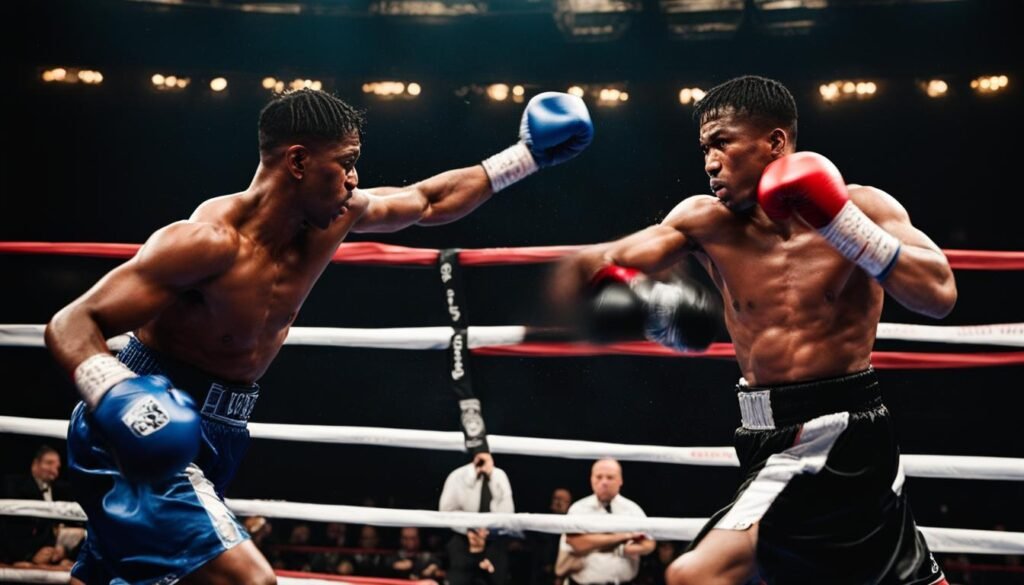
Overall, modern boxing combines athleticism, strategy, and technical skills to provide thrilling and competitive matchups. Whether it’s in the amateur or professional arena, boxing continues to captivate audiences around the world with its blend of physicality and skillful maneuvering.
Olympic Boxing
Boxing has a long and esteemed history in the Olympic Games, dating all the way back to its inclusion in the ancient games in 688 BC. The sport made its modern debut in the 1904 Olympic Games and has been a staple ever since. However, women’s boxing wasn’t introduced until much later, in 2012.
Over the years, the Olympic Games have showcased some of the most iconic and talented boxers in history. Legends such as Muhammad Ali, Joe Frazier, George Foreman, and Sugar Ray Leonard have all competed and made their mark on Olympic boxing.
In the ancient Olympic Games, boxing matches had no rounds or weight classes. The fights would continue until one fighter admitted defeat or was unable to continue. Today, Olympic boxing follows a more regulated format, with rounds and weight divisions determining the outcome of the matches.
Boxing in the Olympics is a testament to the sport’s enduring legacy and global appeal. It provides a platform for aspiring boxers to showcase their skills on an international stage and compete for the coveted Olympic gold medal.
| Year | Host City | Notable Boxers |
|---|---|---|
| 1904 | St. Louis, United States | George Finnegan (USA), Oliver Kirk (USA) |
| 1960 | Rome, Italy | Muhammad Ali (USA), Joe Frazier (USA) |
| 1976 | Montreal, Canada | Howard Davis Jr. (USA), Sugar Ray Leonard (USA) |
| 2012 | London, United Kingdom | Claressa Shields (USA), Katie Taylor (Ireland) |
| 2021 | Tokyo, Japan | TBD |
Boxing Moves
Boxing moves encompass a variety of techniques that can be categorized into stances, punches, and defense. Understanding these moves is crucial for every aspiring boxer to develop their skills and become proficient in the sport.
Stances
One of the key elements in boxing is adopting the right stance. The most common stance is the orthodox stance, where the right-handed fighter leads with their left foot and left fist. This position allows for better weight distribution and balance during punches. On the other hand, left-handed fighters, known as southpaws, mirror this position, leading with their right foot and right fist.
Punches
The art of boxing revolves around throwing effective punches. There are four main punches that every boxer should master:
- Jab: The jab is a straight punch thrown with the lead hand. It serves as a quick and versatile tool for both offense and defense.
- Cross: The cross is a powerful straight punch thrown with the rear hand. It generates significant force and is often used to follow up after a jab.
- Hook: The hook is a curved punch thrown with a semi-circular motion. It aims to hit the opponent from the side, targeting the head or body.
- Uppercut: The uppercut is an upward punch thrown from a close range. It is commonly targeted towards the opponent’s chin or body, intending to deliver a devastating blow.
Defense
Effective defense is essential for a boxer to avoid punches and protect themselves in the ring. Defensive moves include:
- Footwork: Proper footwork allows boxers to maintain a good position, enabling them to evade incoming punches and create opportunities for counterattacks.
- Blocking: Boxers can use their arms to cover their head and body, blocking incoming punches.
- Bobbing and Weaving: This technique involves moving the head in a rhythmic motion, making it difficult for the opponent to land clean punches.
- Rotating the Body: By rotating the torso, boxers can deflect punches and minimize the impact of their opponent’s strikes.
- Covering Up: This defensive tactic involves bringing the gloves close to the face, providing additional protection for the head and body.
- Clinching: Clinching refers to grabbing and holding the opponent to limit their offensive capabilities or buy time to recover.
Boxing Styles
Boxers often adopt different styles based on their strengths and advantages. Some common boxing styles include:
In-fighter: In-fighters focus on short-range combat, utilizing strong hooks and uppercuts to overwhelm their opponents. They excel in close-quarters exchanges and are generally known for their resilience and body punching ability.
Out-fighter: Out-fighters rely on their footwork, speed, and effective jab to maintain distance from their opponents. They excel in long-range boxing, utilizing their reach advantage to strike from a safe distance.
Slugger: Slugger style emphasizes brute force and power punches. Slugger boxers focus on knocking out their opponents with aggressive, high-impact strikes.
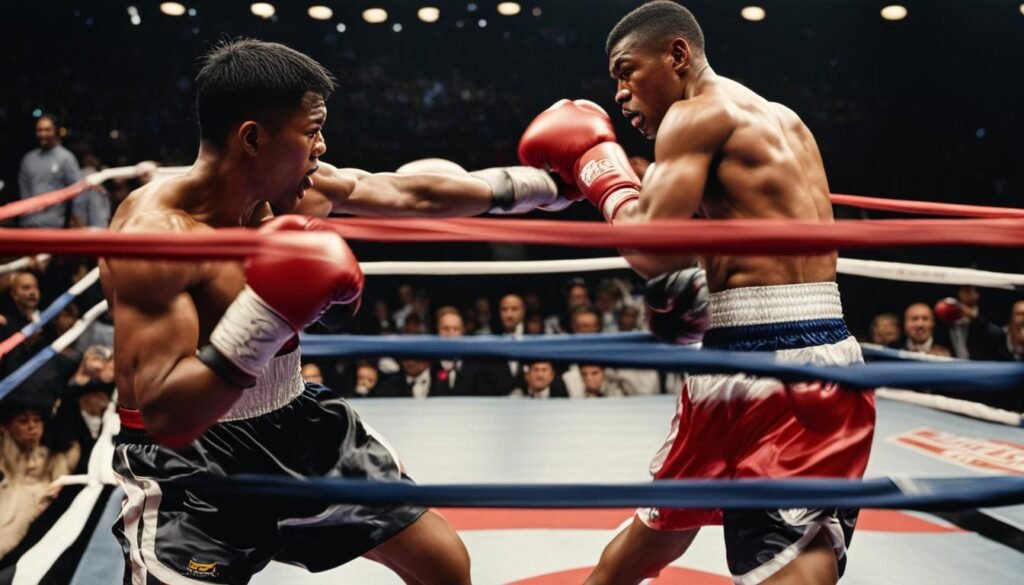
| Punch | Description |
|---|---|
| Jab | A quick and straight punch thrown with the lead hand. |
| Cross | A powerful straight punch thrown with the rear hand. |
| Hook | A curved punch thrown with a semi-circular motion. |
| Uppercut | An upward punch targeted towards the opponent’s chin or body. |
Types of Boxing
Boxing is not limited to the traditional Western style. It encompasses various other forms that incorporate different techniques and focus on specific aspects of the sport. Let’s explore some of these types:
Kickboxing
Kickboxing combines punches with strikes from the legs and feet. It originated from martial arts disciplines such as karate and Muay Thai, with influences from Western boxing. In kickboxing matches, participants utilize a range of techniques, including kicks, punches, and knee strikes.
Shadow Boxing
Shadow boxing is a solo activity where a boxer throws punches in the air without a target. It is often used for technique practice, warm-up, and building rhythm and coordination. Shadow boxing helps boxers improve their footwork, stance, and overall boxing skills.
Fitness Boxing
Fitness boxing is a non-contact form of boxing that focuses on using boxing moves for physical fitness and conditioning. It incorporates elements of shadow boxing, bag work, and cardiovascular exercises. Fitness boxing classes are popular for improving strength, endurance, and overall fitness levels.
These different types of boxing offer unique experiences and training methods, catering to a wide range of interests and goals. Whether it’s the power and precision of kickboxing, the versatility of Muay Thai, the technique refinement of shadow boxing, or the fitness benefits of fitness boxing, there is a style of boxing for everyone.
The Sweet Science
Boxing, often referred to as “the sweet science,” is a term coined by British sports writer Pierce Egan in the 1800s. It encapsulates the mental and strategic aspects of the sport, emphasizing the skill, strategy, and intelligence required of boxers.
Boxing is not simply about throwing punches; it’s about the ability to think ahead, plan moves, and anticipate an opponent’s actions. A successful boxer combines physical prowess with mental acuity, making split-second decisions inside the ring.
At its core, boxing is a display of skill, preparation, and heart. A boxer must possess not only physical strength and technique but also the mental discipline to overcome challenges and adapt to different opponents. The sweet science of boxing requires precision, timing, and the ability to execute a well-thought-out game plan.
Every move made in the ring is a product of thoughtful calculation. Boxers study their opponents, analyze their strengths and weaknesses, and develop strategies to exploit vulnerabilities and maximize their chances of success. In the sweet science of boxing, winning is not solely reliant on physical attributes but rather a combination of intelligence, skill, and strategy.
“Boxing is the ultimate challenge. There’s nothing that can compare to testing yourself the way you do every time you step in the ring.” – Sugar Ray Leonard
Conclusion
Boxing is a dynamic combat sport and martial art that has a rich history spanning centuries. From its origins in ancient times to its modern-day evolution, boxing has embraced a wide array of styles and techniques. This captivating sport has left a profound impact on popular culture and has been an integral part of the Olympic Games throughout history. Although its mainstream popularity in the United States has diminished over time, boxing continues to enthrall millions of enthusiasts around the globe.
Whether practiced as a competitive sport or pursued for fitness and self-defense purposes, boxing remains an art form that combines physical prowess, strategic thinking, and unwavering determination. It requires athletes to display exceptional skill, refine their techniques, and showcase their resilience in the face of adversity. The beauty of boxing lies not only in the physicality and athleticism on display but also in the mental acuity and strategic planning required to outwit opponents.
As the sport continues to evolve, it embraces various forms and styles, from traditional Western boxing to kickboxing, Muay Thai, and fitness-oriented approaches. While boxing’s mainstream popularity may have waned, its legacy endures through the captivating stories of legendary fighters and the unwavering passion of its dedicated fan base. Boxing remains a symbol of discipline, perseverance, and the indomitable human spirit, captivating audiences with its potent combination of athleticism, strategy, and raw emotion.
FAQ
What is boxing?
Boxing, also known as “western boxing” or “pugilism,” is a combat sport and martial art that involves two people throwing punches at each other in a boxing ring for a predetermined amount of time.
What are the basics of boxing?
Boxing basics include learning the proper stance, footwork, and different types of punches such as jabs, crosses, hooks, and uppercuts. Defensive techniques like blocking, bobbing and weaving, and clinching are also important.
What is the history of boxing?
The origins of boxing are uncertain, but it is believed to have prehistoric roots. It spread to different regions including Egypt, Greece, Mesopotamia, and Rome. Ancient Greek boxing was established as an Olympic game in 688 BC, and the Marquess of Queensberry Rules in the mid-19th century laid the foundation for modern boxing.
What is boxing in simple terms?
Boxing is a combat sport where two participants, or boxers, strategically punch each other within a roped square ring.
What is boxing and its rules?
Boxing is a sport where two people, boxers, fight with fists in a match, following rules like the Queensberry Rules, regulating rounds, glove usage, and prohibited attacks.
Is boxing a game or a fight?
Boxing is both a game and a fight, combining strategic gameplay with physical confrontation.
What is the purpose of the boxing sport?
The purpose of boxing is engaging in a physically demanding combat sport, where boxers use their fists to score points or knock out opponents through skillful and strategic punching.

